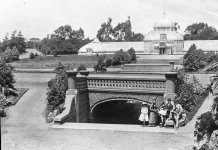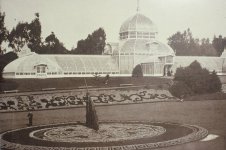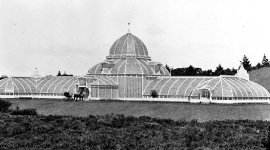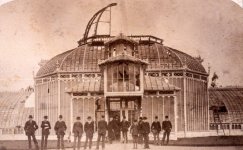Conservatory of Flowers
The Conservatory of Flowers is a greenhouse and botanical garden that houses a collection of rare and exotic plants in Golden Gate Park, San Francisco, California.- With construction having been completed in 1879, it is the oldest building in the park.
- It was one of the first municipal conservatories constructed in the United States and is the oldest remaining municipal wooden conservatory in the country.
- The Conservatory of Flowers consists of a wood structural skeleton with glass walls set on a raised masonry foundation. The entire structure has a shallow E-shaped plan that is oriented along an east-west axis. The central 60-foot (18 m) high pavilion is entered through a one-story, glassed-in vestibule with a gable roof on the south side of the pavilion. Flanking the rotunda to the east and west are one-story, symmetrical wings framed by wood arches. Each wing is L-shaped in plan, with cupolas adorning the intersection of the two segments.
- The octagonal pavilion supports an arched roof that is, in turn, surmounted by a clerestory and dome. The clerestory is supported by eight free-standing, wood-clad, cast-iron columns located within the rotunda and grouped in pairs. Projecting from the pavilion roof on the east, west, and south elevations are dormer windows with peak roofs. Between major arched structural framing members are wood muntins that hold the glass lights on their sides. The lights lap one over one another like shingles and follow the curve of the arches.
- The construction of each arch is aesthetically appealing in its simplicity, but also structurally clever in that it takes maximum advantage of wood as a building material while overcoming its inherent structural shortcomings. From a structural perspective, the arch design utilizes the mechanical properties of the material. Wood is strongest along the length of the grain and weakest along the end grain. The use of short arch components with shallow radii minimized the amount of weaker-end grain exposed to structural forces. The assembly of the arch with several small pieces of wood, the shapes of which are identical from arch to arch, was efficient. It allowed the fabricator to set machines with guides and templates so that cutting the multiple-arch components was a simple task. Furthermore, the design required little material, since each individual arch component has only a shallow radius. Moreover, by using relatively narrow widths of lumber, the chance of warping was minimized. Finally, there was an efficiency realized in transportation, as the small size of the arch components allowed them to be easily stored and shipped.
- The structural wood arches and their method of construction, along with the decorative woodwork and unique lapped glazing, define the character of the conservatory. The major character-defining elements consist of ornamental and structural woodwork, including the method of fabrication used for the arches, the lapped glazing system, the ventilation system, and the building's siting and exterior landscaping.
History
The conservatory kit was bought by James Lick, an eccentric businessman, piano maker, and successful real estate investor who was a patron of the sciences. It was intended for the City of San Jose, where Lick had built a mansion surrounded by exotic plants imported from South America and around the world.- Lick died in 1876 before constructing the conservatory on his estate, and it was put up for sale by his trustees.
- The kit was then purchased by a group of prominent San Franciscans, including Leland Stanford and Charles Crocker, who offered it as a gift to the City of San Francisco for use in Golden Gate Park.
- The Parks Commission accepted the gift and hired Lord & Burnham, a greenhouse manufacturing company from New York, to supervise the erection of the structure.
Lord & Burnham
The company began in 1849 when Frederick A. Lord, a carpenter, started building wood and glass greenhouses for neighbors in Buffalo, New York. It became Lord's full-time profession in 1856 as production moved to Syracuse, New York and then to Irvington, New York to be closer to his customers in the large Hudson River estates.- In 1872 Lord's son-in-law William Addison Burnham joined the firm.
- Their first major commission came in the 1876 when California philanthropist James Lick hired the firm to create a 12,000-square-foot (1,100 m2) conservatory similar to that in Kew Gardens.
- Its parts were fabricated in New York and sailed to California.
- After Lick's death, it became the Golden Gate Park Conservatory of Flowers.
- In 1883 the partnership incorporated as Lord's Horticultural Manufacturing Company, and in 1890 the name was changed to today's Lord & Burnham Company.
- Beginning in 1894, the company purchased underwater property beyond the tracks and began filling in to create new land for an expansion.
- Say what?
L & B Conservatories
The company's early greenhouses were made of cypress and iron or steel. Although experimentation with aluminum began in 1932 with the United States Botanic Garden, commercial production was not economical until 1955.Major Lord & Burnham conservatories include:
- Phipps Conservatory & Botanical Gardens, Schenley Park, Pittsburgh, 1892–1893
- Buffalo and Erie County Botanical Gardens, Buffalo, New York, 1895–1899
- New York Botanical Garden, 1899–1902
- Sonnenberg Gardens and Mansion State Historic Park, Canandaigua, New York, 1903–1915
- Reynolda Gardens, Wake Forest University, Winston-Salem, North Carolina 1912
- United States Botanic Garden, Washington, DC, 1933
- In 1838, Charles Wilkes set out on the United States Exploring Expedition commissioned by Congress to circumnavigate the globe and explore the Pacific Ocean.
- Wilkes returned in 1842 with a massive collection of plants previously unknown in the United States.
- The live specimens and seeds came to be housed in the Old Patent Office greenhouse, and were cared for there until 1850.
- At that time, a botanic garden was built to house the collection in front of the Capitol, where the Capitol reflecting pool is now located.
- In 1933, the building was moved to its present location.
- Question: when was it built?
- Volunteer Park Conservatory, Volunteer Park, Seattle, Washington, 1912
- Who would have thought?
KD: Figured this fun story was worth sharing. Wondering how this structure survived 1906...
- The San Francisco earthquake and fire of 1906 did little damage to the Conservatory of Flowers.
- The structure is visible in a number of photographs of refugees living in Golden Gate Park after the disaster.
- However, records indicate that reconstruction costs ensued to the surrounding landscape from refugees living in the park.





